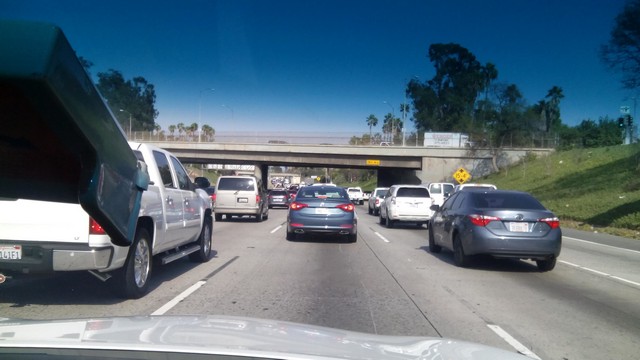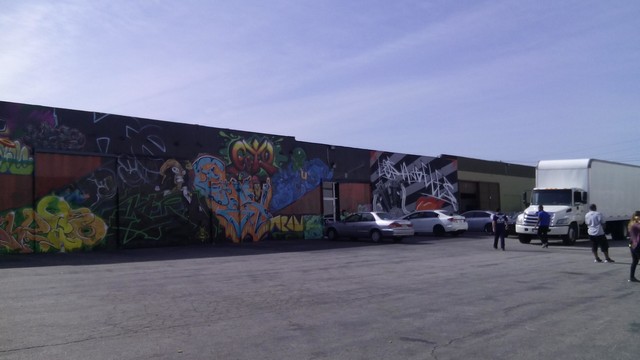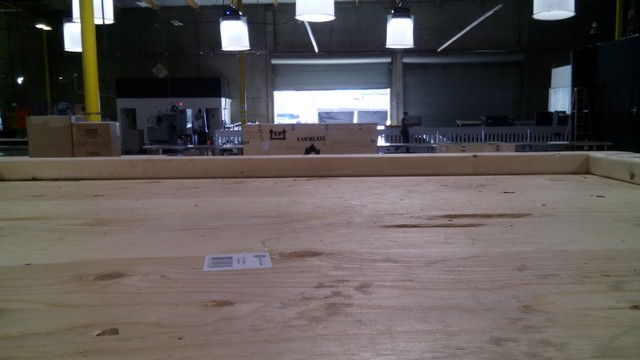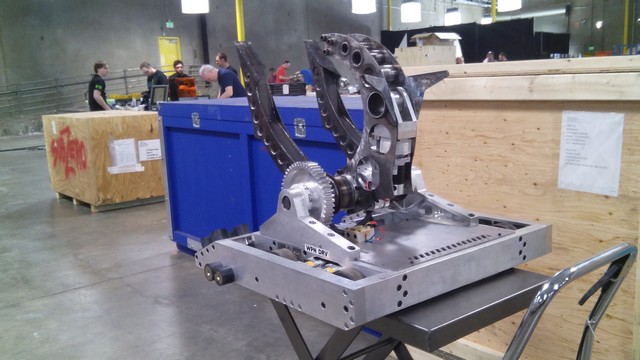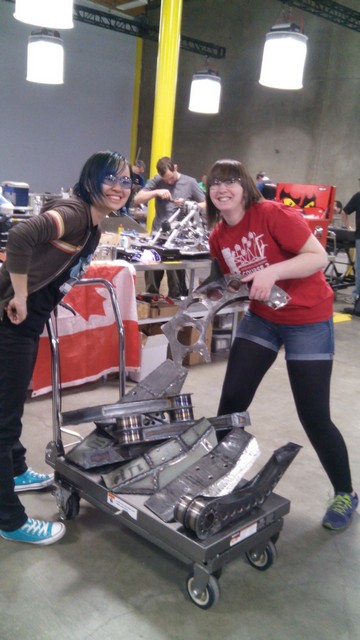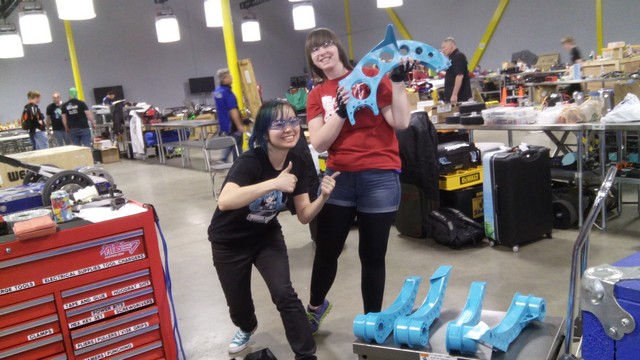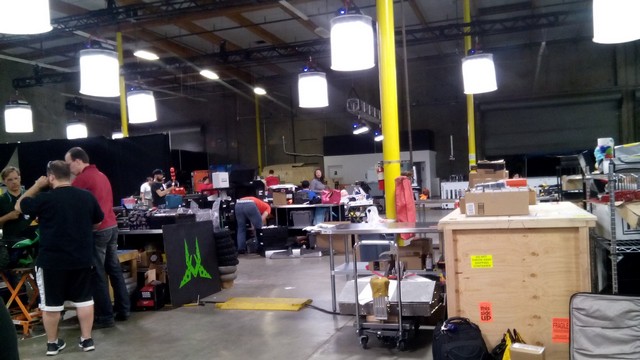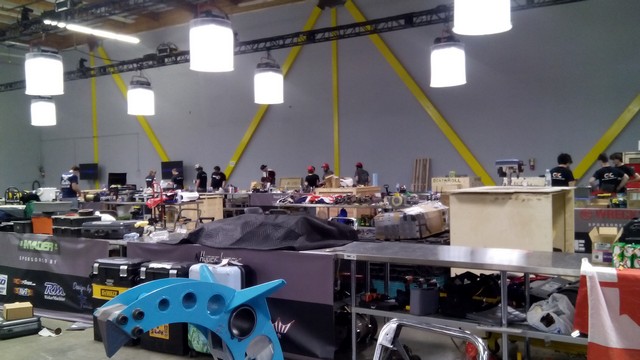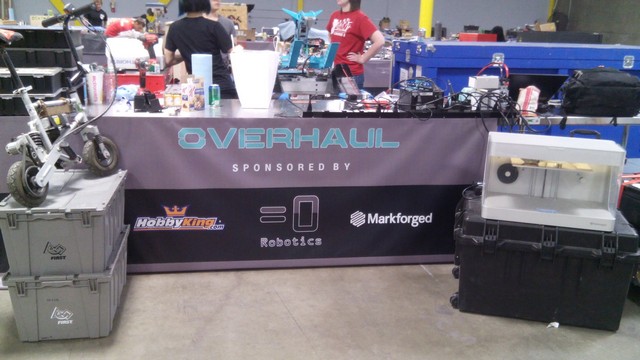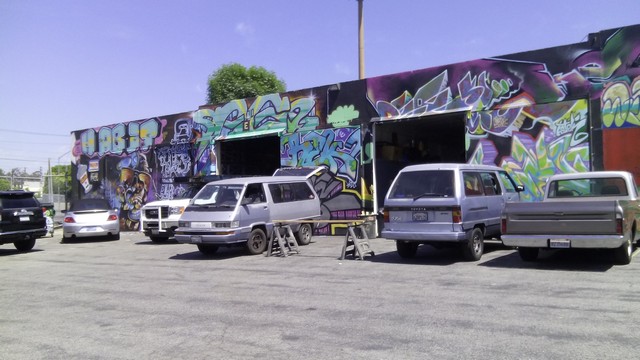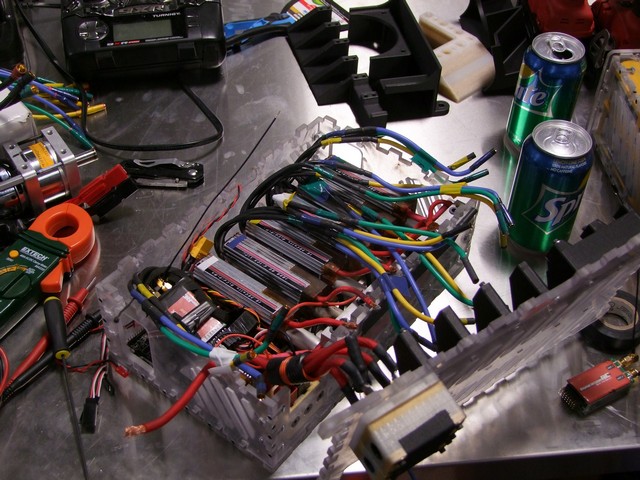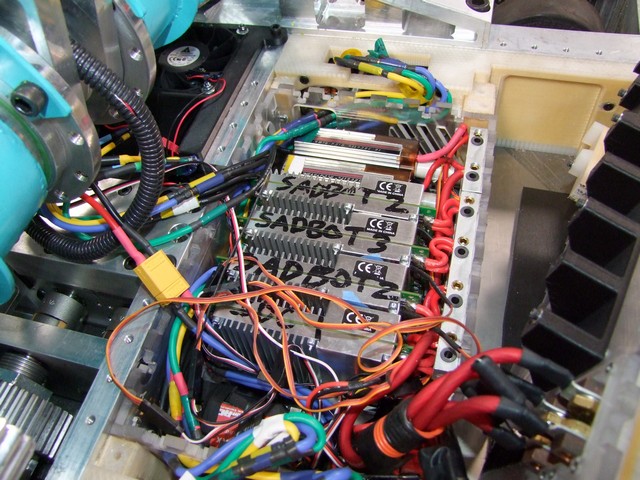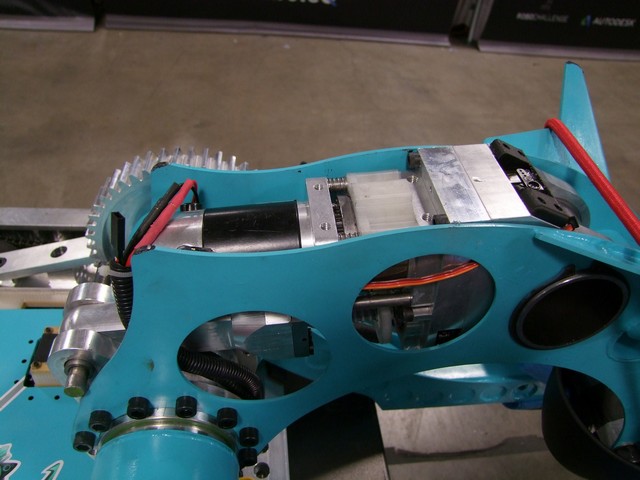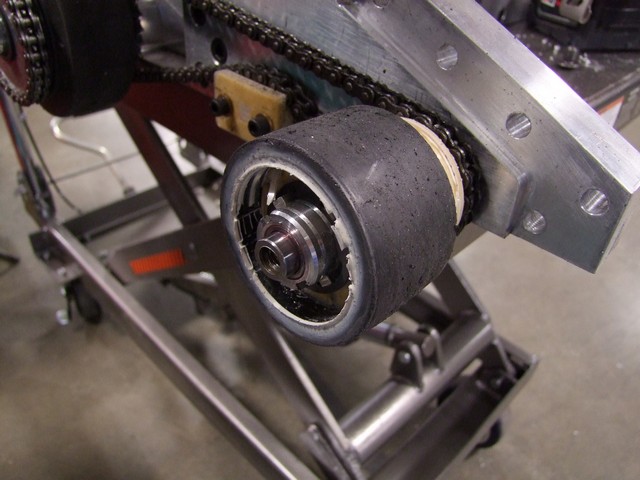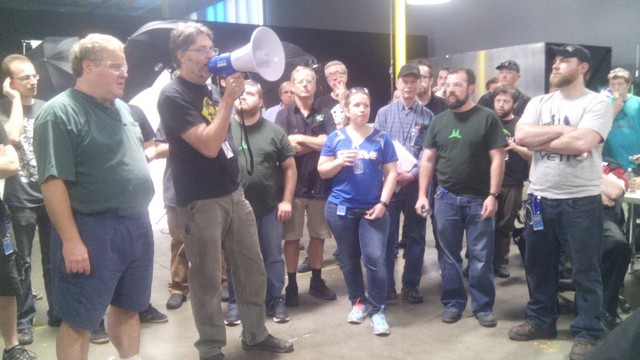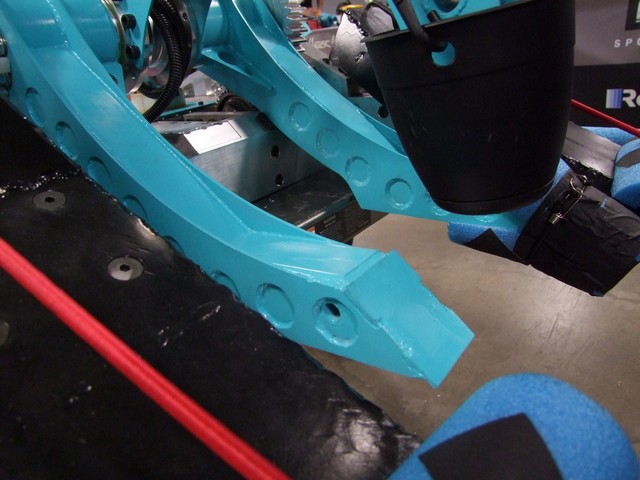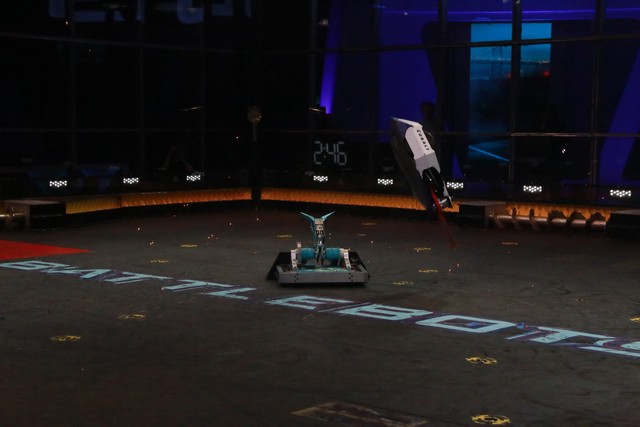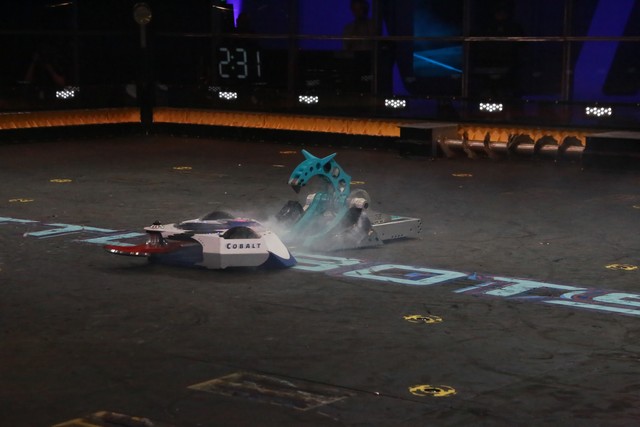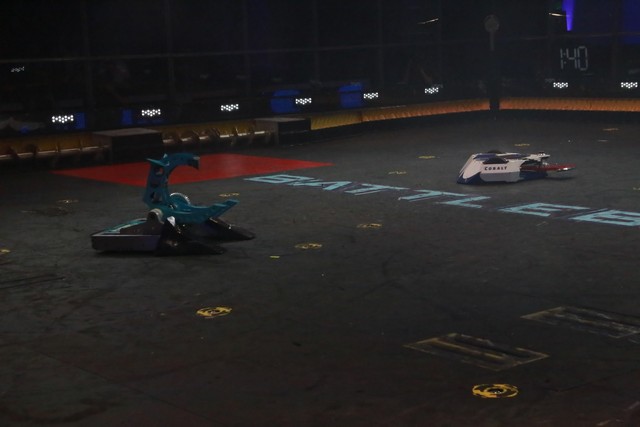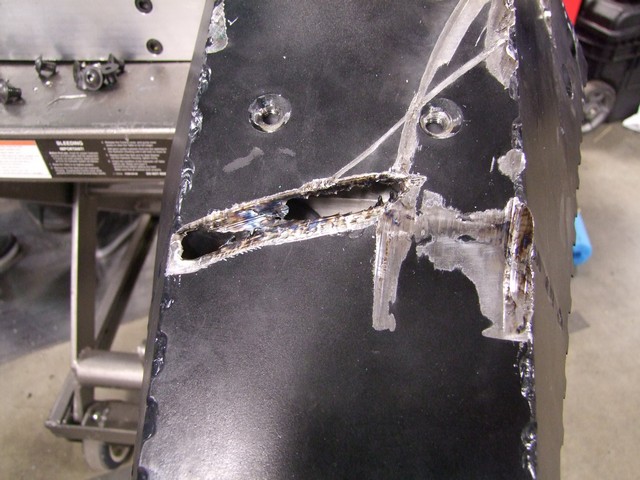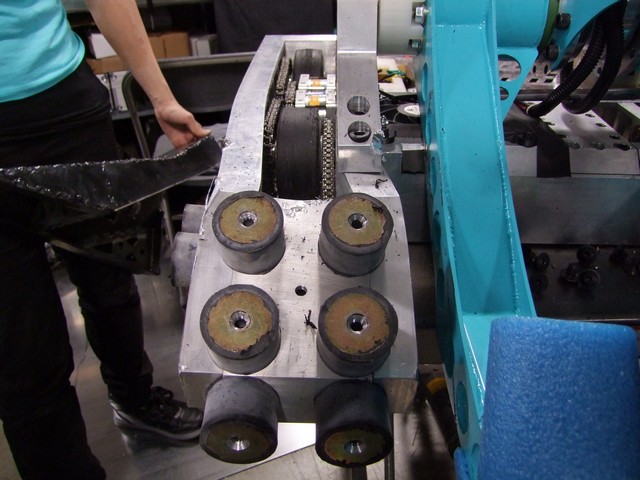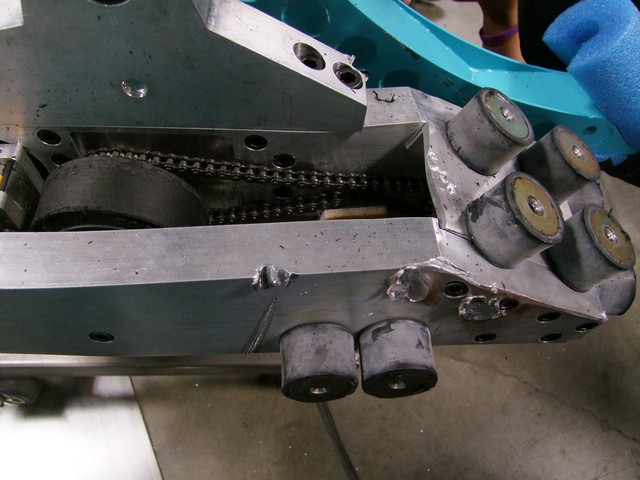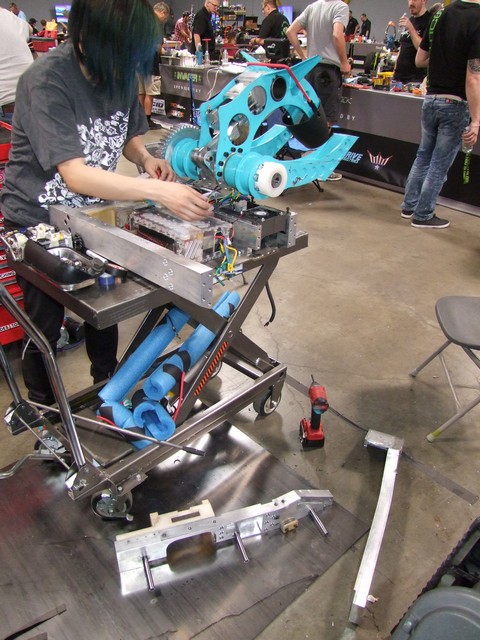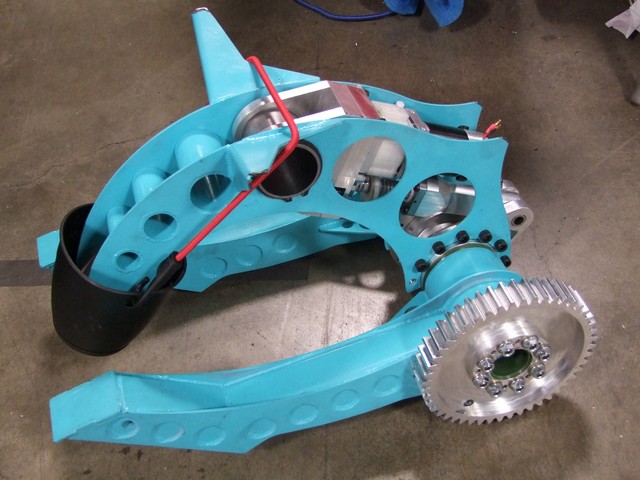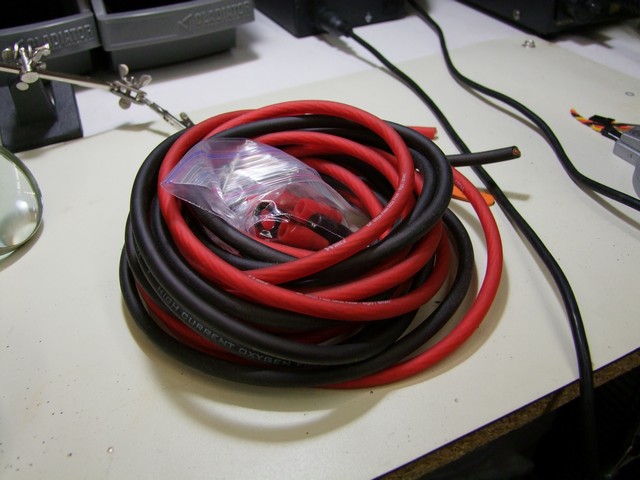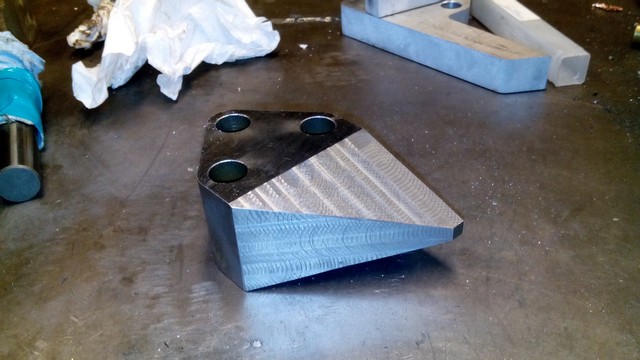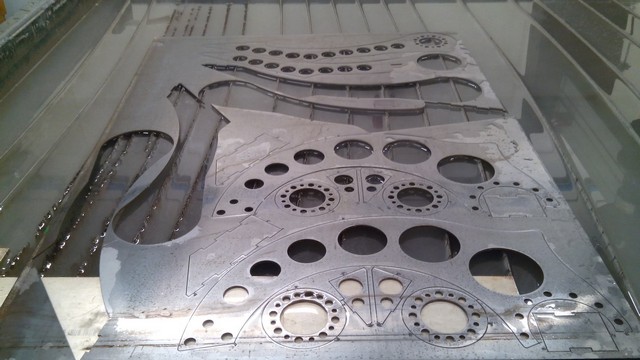OMG WASN’T THAT AWESOME? IT WAS TOTALLY AWESOME. I THINK IT WAS….
Okay, you get the idea. That’s what I’m going to say about every episode of BattleBots. I was there, man.
This post will dive into the details of the Overhaul vs. Cobalt match that was aired on 6/30, so what I’ll do as a favor for those who haven’t seen it – as people who haven’t gotten to see it live will probably see it with a DVR or via streaming over the next few days – is begin by talking about the event itself. Basically, there was a few days before the first matches even began where a lot of preparation was being done, and robots being, umm, finished. That way, we have a sizeable spoiler gap before getting to the match itself, and lastly what I’ll do is discuss the lead-up to the Cobalt fight, what happened during, and the results & work after. So don’t scroll too far down if you don’t want spoilers!
Here we go! After landing in Los Angeles around 2PM on the 14th of April, it took over an hour to get a rental car at LAX… because apparently everyone was also in town for Coachella. I heard from builders who arrived later that the situation only got more desperate, with some waiting over 3 hours for their allegedly guaranteed reservations. No free upgrades for you.
Now, given that it was getting close to 4PM by the time we finally high-tailed it from the airport, it was only natural that we…
…sit in traffic. The distance from the airport to the venue was about 45 minutes during a good time, and now was not a good time. Let me make it very clear that I’ve basically forgotten how to drive a normal, modern car. If you saw me make my way over from airport, you would have sworn I got my license yesterday. Mikuvan: Elevated view, infinite visibility, super short turn radius, and middle wheels only, bitch. That often means an extra 2 to 3 feet of maneuvering space since I can overhang the curb and eat a sidewalk momentarily. Modern car: I can’t see shit, I can’t turn worth shit, I have no clue where the rest of the car is but boy can I go fast. A I R B A G S.
Having to remind myself that I have an extra 5 feet ahead of me that can’t touch anything is a very demanding task, and it keeps me paranoid. Hey, that’s defensive driving right!? Plus, the first time I missed a turn going to dinner and had to swing a U-turn, I didn’t even think twice before almost plowing the fuck perpendicularly into the opposite sidewalk….. because Mikuvan would have made that turn fine, but apparently that’s too much to ask of a 2015 Nissan Maxima. Kids these days.
We actually didn’t end up going to the venue at all on Thursday, as they were still setting up everything, and apparently word on the street was that only international teams were permitted on site during this time. So we hit up the event hotel, another 15 minutes east, and decided to settle in for now and formulate a, umm, battle plan for the weekend. There was a trip to Home Depot to pick up spraypaint so we could finish off the bot, which was unpainted when shipped.
Fresh and early Friday morning!
The venue was a series of rounded warehouses in an industrial corner of east L.A., which calls itself the cutesy name of L.A. Hangar. No, none of those buildings are hangars, they’re round warehouses. You’re no where near the airport. I promise, because I just came from the goddamned airport.
The neighborhood was “interesting” to say the least – primarily Hispanic and touted as “that part of town” to me, but hanging around made me wonder if this was actually the case, or *side-eyes* watch out for those Mexicans, man. Okay, fine, there was that whole manhunt which had the whole venue on lockdown and a police perimeter around the neighborhood and all… but the weekend corner taco stand beat out any of the food trucks there by kilómetros.
This isn’t a photo of the venue, by the way, but of the artists nest in the building right next to it. This building will come into play later.
Hello neighbor.
Our bot crates were lined up neatly in front of our pit tables already, so the only thing to do now is unpack everything!
Ah, we meet again. That’s right, I did build one of these… I thought the last 3 months might have been a hallucination, that or someone drugged me and stole $17,000 while telling me I built a robot and that everything is okay and I was still a grown-up.
That number is not even close to being a lie, by the way, and I was by far not the most machining-heavy bot there. Oh shit, this is real.
Step 1: Pile everything on the pit table first, think about your life decisions later. After we were done unpacking, two dudes with pallet jacks double-teamed my giant 8 x 4 foot crate into the storage area. Everyone else took just one! I took two guys! AT THE SAME TIME! Wait, what were we talking about again?
Step 2: Take the whole bot apart, and have Paige and Cynthia do the very important task of painting it while I set up the battlestation.
No, this is not “have the girls do the art” – after Overhaul 1 showed up naked to BattleBots last year, and with us having built the robot brand already around the Miku-blue, there was no way they would let me fuck it up. Because don’t you all know that adding paint also adds about 27 to 33 points to your Tail of the Tapeworm score? Overhaul 2’s getting AT LEAST 65 in the DASHING GOOD LOOKS category here, guys!
After putting together the toolbox and lining up my EE tools, I went outside to check out how they were doing.
There was a van!
Outside the Artsy Building was a blue 1985 Toyota 4×4 Van. I didn’t know who it belonged to, but it was someone who worked in that building. Van bros!
I was totally scouting Craigslist the whole week trying to see if there was a cheap van I could buy on-the-spot in SoCal and then drive back across country. Based on the Mikuvan Extraction Mission, there was ABSOLUTELY NOTHING that could have gone wrong with that plan. Nothing.
Late in the day on Friday, and the primer & paint’s dried enough for us to bring everything back in. We would let everything fully dry overnight before putting the bot back together. Not shown here are the pontoons, which were still drying at the time – they’re painted flat black.
SATURDAY!!!!! It’s the day after Friday.
A view of the pits from our station facing the entrance of the venue (beyond the wall is the Artsy Building). Mutant Robots and Don Hutson to the left, and in center stage is Blacksmith. The New and Improved bunnyforce Bite Force is in the distant center.
180 degrees from that shot, and Hypershock is under a blanket, lying in wait. Behind that row is a contingent of British bots, with Cobalt on the left and the Crunchy Candies Creepie Crawlies across the aisle.. There were more pits to the left and right of this, obviously, but I’m gonna skip that for now because Hey, a robot! Look, another robot! This is a robot too! We’re all robots! YAAAAAY!
Saturday is “pretty pictures” day. So we assembled Overhaul in full, with the painted parts.
Obligatory sponsor shot!
Hobbyking, our future overlords, provided the majority of the important parts for OH2 that were not machining. Like we’re talking motors, controllers, my radio, batteries, chargers, and support equipment for all of that. They legitimately handed me around $7K of parts. Do you know how much $7,000 of Hobbyking is? For those of you who might not have purchased things from Hobbyking, that is a lot of Hobbyking.
MarkForged dropped me off a Mark Two printer specifically for this event, which I put to work immediately – you’ll see what it’s printing soon. Beyond that, if you ever don’t feel like machining something, we’ve got your back. You’ve seen MarkForged parts in action here on Chibi-Mikuvan primarily in the steering assembly. You’ll notice that many parts were printed in a black material – this was Onyx, a carbon fiber filled nylon, which was still secretly in beta testing at the time of the tournament. Check it out! This stuff is actually ridiculous.
PRETTY PICTURE TIME! We begin with the 360 degree bot shot, which is where the hovering robot icons in the background of the hosts come from. This is shot in front of a greenscreen that is actually gray. We’ve somehow gotten to the point where computers can automagically tell between a gray piece of cloth and a gray robot. May Robot Jesus save us all.
These are edited pretty much on the spot and the result piped right to the production floor. They need to assemble all of this by the start of matches, after all.
A visit to the arena, still having final light, camera, and action rigging done. This is in a separate roundbuilding which you actually have to move your bots a fair distance – probably around 500 to 1000 feet – beyond the Artsy Building to get to.
Once again, this is real. It didn’t feel real last time, at least not RIGHT UP UNTIL the worbly light and sound mindfuck they do right at the beginning of the match when the countdown starts. That, last season, for me, was when it finally hit me that I was actually at BattleBots and holy crap Donald Hutson is coming at me. I had a miniature internal panic at that point.
For those of you who might be coming to #season3: Prepare for the Worbly Light & Sound Mindfuck. Fear it.
After this arena visit, I ran back to the pits and….
There are two vans.
Hold… Hold on just a second here… earlier, there was just one van. A second identical 4×4 Toyota Van showed up, and along side it a lowered classic pickup truck.
I actually ran inside and hunted down the owners this time, like some van-themed serial killer. It was a married couple, and these were fucking HIS AND HERS MATCHING 4X4 TOYOTA VANS. Okay, some times people call Cynthia and I nerd-cute for having matching hair and the like, but I’ll never convince her to have matching vans. This is… I dunno, grease-cute. Gear-cute. Faruq, King of Dubious Robot Puns, I call upon thee to help me the fuck out.
Alright, universe, you win. I’m going back to work on robots. Like a nerd.
Recall that before we shipped, I had prepared all the remaining DLUX 250A controllers I had to be installed when we got on site. This is now the time.
The plan was to run the 250s on the drivetrain only, since they were known to be reliable, and leave the DLUX 160 controllers on the lifting forks. That way, I maximize reliability for the highly pivotal first match – either you win, or you have to vie for the wildcards, which could mean it’s your one and only match.
In the background behind the extracted ESC box is one of the parts I set printing “live” on the Mark Two – it’s a “four 250A and two 160A” mount. Another one is attached to the lid already in the foreground.
An ESC swap sounds simple, but in reality, it was a lot of time-consuming rewiring. All of the 250A output wires had to be remade, as did the extensions to exit the box, since the spacings were different. This took the better part of Saturday evening and into Sunday afternoon…
SUNDAY! SUNDAY! MORE SUNDAY THAN YOUR BOT HAS WEIGHT FOR!
Work continued into Sunday on the wiring job, which is shown here basically finished but not yet well packed. Up until this point, we haven’t even gotten a chance to drive the thing in the test arena yet, and we were all getting a bit nervous.
I moved onto closing up some unfinished business, which was the P90X. I designed and had printed earlier a servo mount that you see attached to the right side of the actuator. This holds a standard-size helicopter servo from Hobbyking.
Unfortunately, this was as far as the P90X implementation got. After some rumination, I decided not to chance this part in battle if I haven’t already tested it and found that it works reliably. The P90X work fell by the wayside as the robot build moved on, and I never really came back to it.
This will be a science experiment for another day. For now, I locked the ring gear into high (even though it spring-defaults to high, having something hold it there is better) so I prioritize grabbing speed over holding force.
Here is the aftermath of our first test drive in the box. This was when I realized that the front wheels were likely going to cause a lot of trouble, and that I have no clue how to glue things together. The “urethane adhesive” from McMaster did not adhere all that well. Lacking bail options on this part, I just swapped a front wheel (6 were made, so there were plenty of spares) for now and decided to see what happens.
I also discovered at this point that Overhaul took a bit more effort to self-right than I anticipated. It took me a few tries, first of all, to actually gather enough bravery to run the forks hard backwards such that the clamp hit the top plate. It clutched itself as designed, of course, but there’s that nervousness that comes with an untrusted and untested power system. Once I just beasted it into itself, Overhaul could self-right fine, but as known from OH1 and the new CAD model, could only do this if the clamp arm were somewhat open – above about halfway open. I had to practice going “up and to the left” on the radio stick, which from OH1 as well as Uberclocker was “Lift up forks and open clamp”. This was going to be an artform if I were in a self-righting critical match, such as Bronco or a vertical spinning weapon that caught a good bite on the frame’s underside.
With the wheel replaced and self-righting mostly conclusive, it was time to call it a night.
MOOOOOOONDAAAAAAAAY
This was it.
We get to find out who we fight first! Monday was “practice day” by the tournament schedule – the “Alternate” entries get to run around in the box with full introductions and ceremonies, so everyone has a chance to run through their lines and get in position, and the camera crew learns how to not zoom in too hard on your robot’s acne.
Producer-bro gives everyone the “don’t impale yourself” speech before everyone moves over to the bleachers, where Aaron, one of the executive producers, primes new builders on how things went last season and how they were expecting to do things this time.
I didn’t get any pictures of this process, but as they dramatically announced each robot, the team would stand up…..then they announced the opponent, and the other team stands up. There was then several seconds of awkward searching for each other before locking eyes and usually doing something intimidating as best as robot builders could possibly, which is to say….. not very. I really, really hope a “BattleBots Outtakes” package becomes available somewhere on the black market, because this was quite priceless. Hell, I even forgot what we did once Cobalt was announced, but it was probably something cringeworthy as par for the course.
Alright. Strategy time! First, we went back to the pits and
There are three vans.
THREE! THREE VANS! IT WAS THREE!! AND COCO WAS ITS NAME! I ain’t goin to heaven no more… I already sold my soul to Trey Roski.
I quit life.
note: I did not know if the 3rd van was actually named Coco, but if you get this reference, congratulations.
We switched Overhaul to its short arms. Wait, what?!
These didn’t make an appearance during the design and build, because they were a bit of an afterthought. They are essentially the arms but cut off about 5″ shorter and at a 45 degree slope, leaving the bot a little stubby looking. They are specifically designed to rest behind the armored pontoons. This is my “spinner configuration”, especially for horizontal weapon.
My basic plan? Use the pontoons exactly as designed – fend off the blade, use Cobalt’s energy against itself, and go in for the grab once it’s disoriented or neutralized. The specific goal was to get the blade to ride up on the pontoons and then hit the second angle level, which will ideally destabilize an already rotating bot. Keep the front pointed the right way at all times, and let the rubberwubbies do their job.
Did I succeed? Spoilers lie ahead.
Overhaul vs. Cobalt
Boink.
Whee!
This is fun!
Everything worked quite according to plan. If you tuned in and watched the (sadly, just in highlights – damn you, ABC!) match, you saw Cobalt sail end over end repeatedly, bouncing off the pontoons. Geometry! I didn’t approach as squarely as I wanted to on a few occasions, which results in damage that will be analyzed shortly, but for the most part, this match was highly entertaining.
After 3 or 4 rocket-jumps, Cobalt began smoking significantly and losing power. The impact forces caused the weapon motor, an original ETek* motor, to begin self-destructing internally. There were several more smaller-magnitude impacts after this, and we were only 30 seconds into the match. I kept the forks down and clamp all the way open as long as it kept spinning.
*Robot nerds will point out that Cobalt used a Manta motor, which is a reconstituted freeze-dried ETek. This company bought Briggs and Stratton out of remaining ETek parts after production ended and assembled a short run of their own, advertised as wind generators, but they work okay as motors too.
Unfortunately, you probably also saw the end result: Overhaul loses a drive side, then kind of sits there and flails while Cobalt contemplates existence in a more mobile, hence less county-outy fashion. Overhaul was declared knocked out around 1:30, but really I had mobility problems starting around 2:30 remaining (Note: These times are rough mental estimates, and I will not remember more until the full match gets uploaded).
EDIT: BattleBots has uploaded the full match video! My memory wasn’t that horrible after all. Around 1:31 in the video (30 seconds into the match) was the last time the left side drive was working.
Well, that part didn’t quite go according to plan… Let’s see what went down!
First of all, damn. DAYUM. Cobalt packs quite a punch – enough to straight up pierce the AR400 5mm plate weldments, in several spots.
One of the first connects actually machined off a sliver of the left-side pontoon. The big smear to the right of that is “everything working exactly as intended” – the blade hits the pontoon, glides up, and exits stage right. That hit I’m pretty sure actually sent Cobalt somersaulting over ….haul. I will need to slo-mo the fight to be sure.
Overhaul didn’t look too bad exiting the arena. Nothing was missing, or cleverly collapsed into itself, Ghost Raptor style, but the extent of the damage was discovered as soon as the pontoons came off.
yikes
Oh boy. Those are two 1.5″ section frame rails that now look like a real-life FEA simulation result. That’s a whole lot of energy, people.
Surprisingly, this side never bound up, and was working up until the end of the match. Hurray chain slop!
I surmise that the hard side-blows that Cobalt dealt pushed the pontoons sideways until the shock mounts bottomed out, at which point steel met aluminum. The linear gouge to the left is the side of the pontoon hitting the frame rail. However, the actual cause of the bending is probably the two hits (which line up with the two holes in the right pontoon) which seems to have connected AR400 straight to aluminum, with the energy of the blade behind it. I will need to review the match to see exactly which hit this was.
Cobatl definitely hit me going across the front at least once, with this nice dig out of the metal here.
So. We lost our first elimination match, but there is still a shot at the Wildcard picks. Wildcards are usually picked by a combination of factors, one of which is how ready you are when they come around to stare at your robots. Therefore, this thing is getting fixed up, and now is where my investment in two full frames’ worth of spare parts pays off.
We begin ripping the sides of the bot off – some screws had to be coerced back out, because duh. The right side was the most damaged, but the front left tire fell off during the match, so it has to be removed. That means the left side had to come off also, and that’s when we found it.
Can you see the FUUUUUUUUUUUUUUUUUUUUUUUUUCK in this picture?
When Overhaul’s left side stopped moving, it wasn’t totally dead, but was capable of moving back and forth maybe 2 inches before stopping again. I was pretty sure one of the P80 drive gearboxes was stripped as a result. But something didn’t quite make sense when I was moving the drivetrain back and forth by hand in the pits. Those motors could spin more than a full revolution. Those gearboxes are fine…
Can you see it yet?
Here.
Oh dear. There’s a set screw caught in my drivetrain.
Yes, ladies and gentlemen. A single 1/4″-20, cup-point set screw fell into the intermediate chain and locked both drive motors up. But where did it come from? There was only 1 place nearby that I use 1/4″-20 set screws – the motor’s double sprockets. But I used custom flat-point set screws, and all of mine were still there.
That means Overhaul picked up and ate a set screw, which fell off someone else’s robot in a previous match, which landed in exactly the correct location to cause total drivetrain failure. My guess is the front wheel kicked it up and over the middle wheel, it landed in the intermediate chain and sprocket area, and a chance impact jostled it into the motors. This screw was forged into the chain and needed prying to remove. It also took out the sprocket teeth that made contact with it, as seen in the example above.
So in the pits, they have mini production teams running around filming interesting things. You could also flag one of the production staff down if you were doing something interesting, and they made an effort to divert camera and sound crew over to what you were doing. They really did go out of their way to try and capture the frantic robot work in the pits, make no mistake. I exercised this privilege and actually got a team over to film a very quick but very angry rant about how you can be utterly … screwed… by something totally out of your control and up to chance, no matter how much you prepared for it. I was pissed. In an alternate universe where BattleBots is filmed and produced my way, my angry rant against the robot gods would have taken up the entire minute long highlight.
By the way, we think we know which robot it was – and its builders are also fairly sure of it. But we’re not going to spoil it quiet yet!
Overhaul here seen at its Point of Maximum Entropy on the repair path. I eventually put back together the damaged side on its own, and if you visited any of the places I brought the bot, or the Artisan’s Asylum, this is the Science’d frame rail I displayed. Now you know what happened.
I posted a Facebook photo not long after this match with the caption “The front fell off”. It attracted a lot of speculation and attention, but was completely innocent. We in fact just slid the whole fork and clamp assembly off to open up more space to work on the frame rails.
Within about 2 hours, the frame rails had been replaced with spares. In total, it took about 4 hours of work to get everything back together, and we finished Wednesday evening. The only thing to do was to wait for the Wildcard Ceremony the next day (Thursday).
Thursday was designated as a “Repair day”, which means McMaster-Carr made bank off all of us. There seemed to be a continuous ant trail of builders going to the L.A. McMaster warehouse, and… oh, I’M SO HAPPY THERE’S A L.A. McMASTER WAREHOUSE. Now, the plot twist here is that we had nothing left to repair after the frame pull, so we spent much of Thursday hanging out with the other builders and relaxing.
If you watched BattleBots S2E3 until the very end, you’d have seen the (much more hurried) Wildcard selection, which concluded with……………………….us. This happened in real life, too, and I think it alone contributed 50 years of aging to my cardiac health state.
Now we’re up against BETA, which is…. another British bot with a friggin ETek driving its weapon. I can NOT catch a break this event, eh? What’s going to happen? Well, I don’t know which episode it will be on yet, but for sure there will be another post-fight analysis! So stay tuned to BattleBots on Thursday nights at 8/7c, because we need those sweet, sweet ratings.
